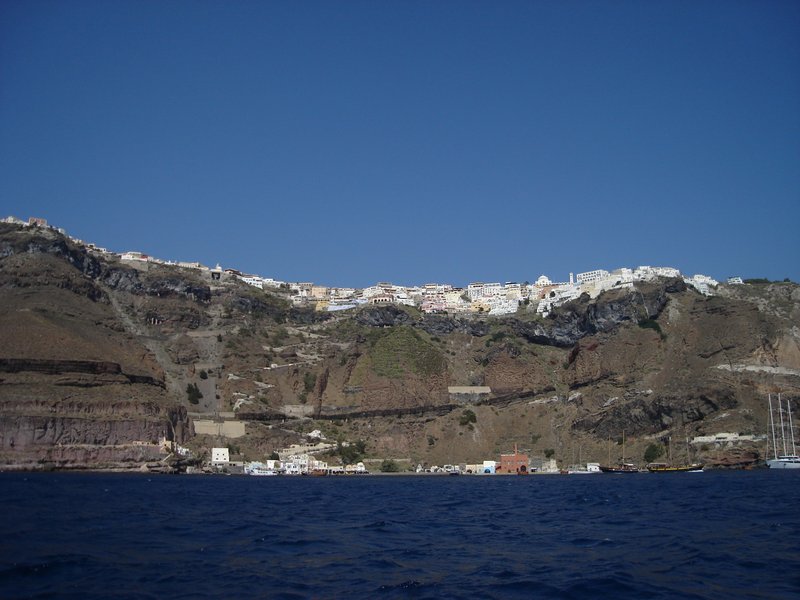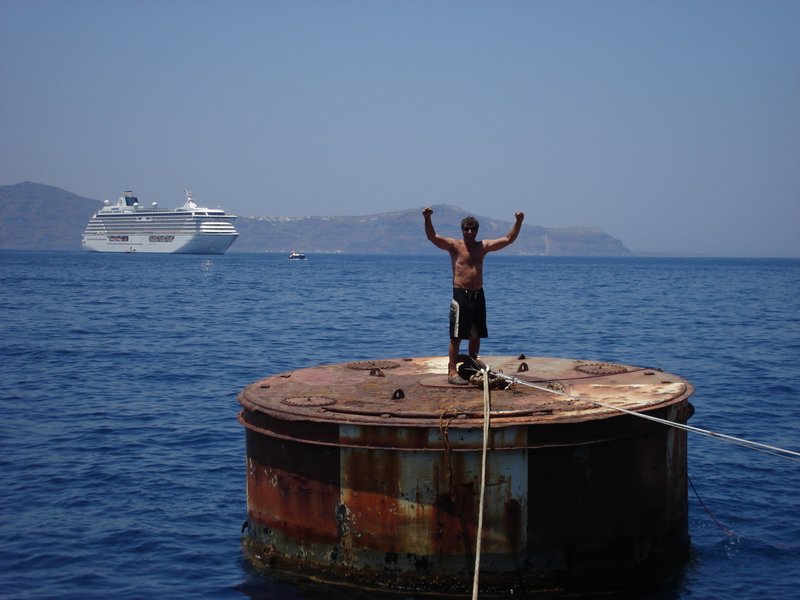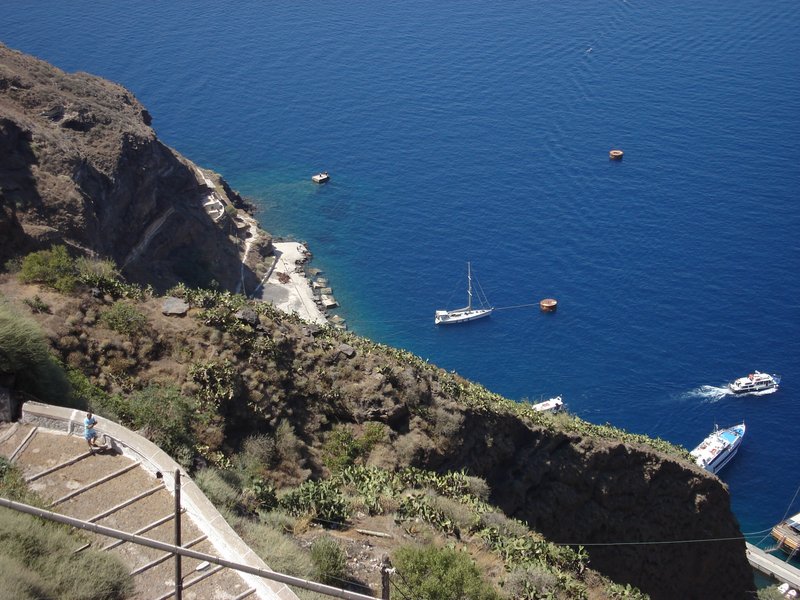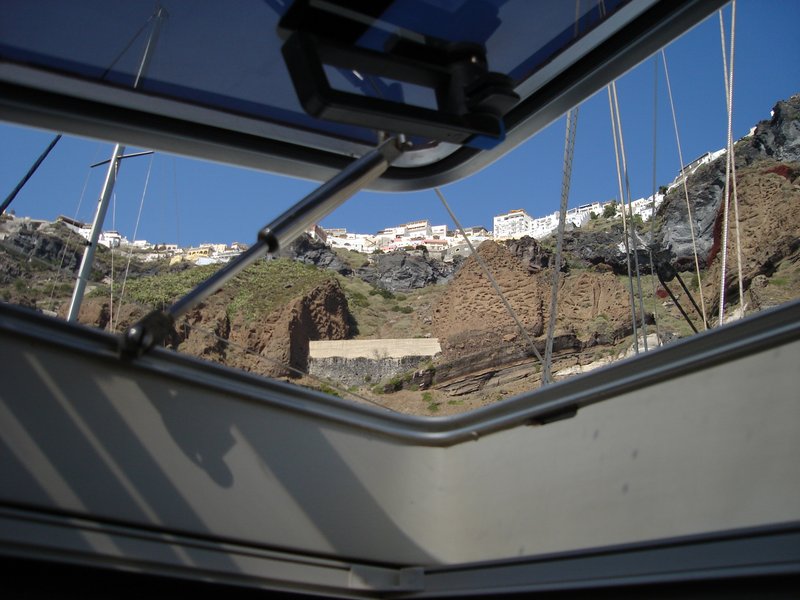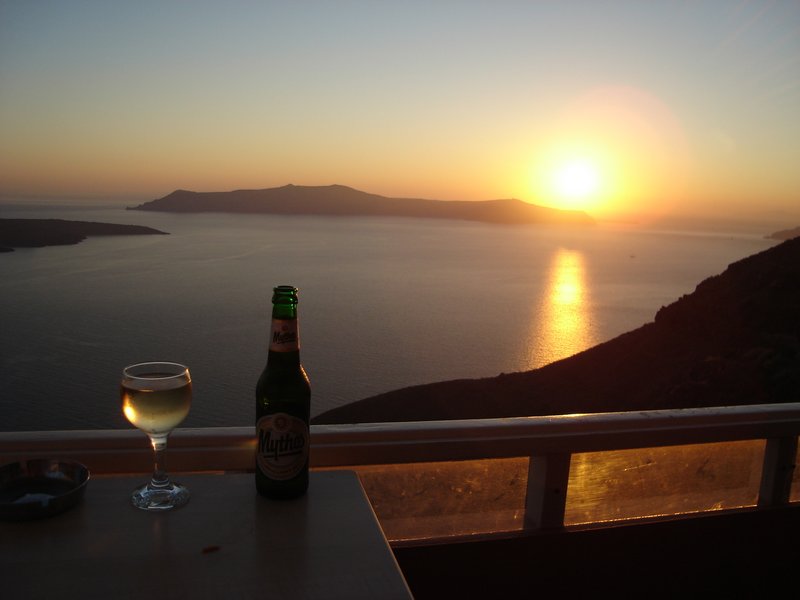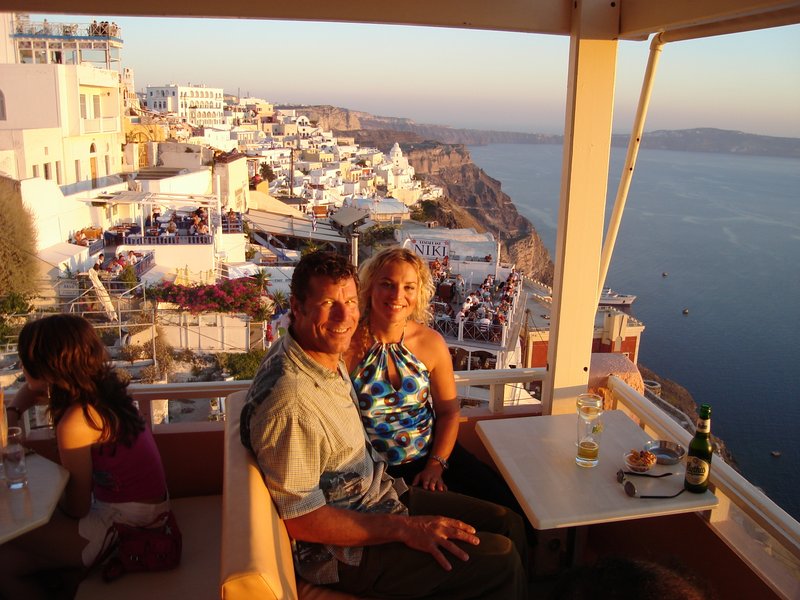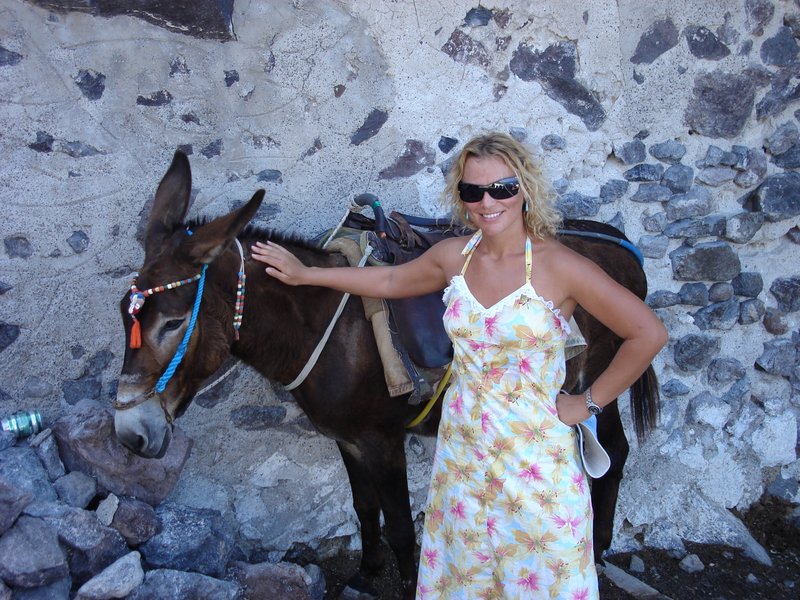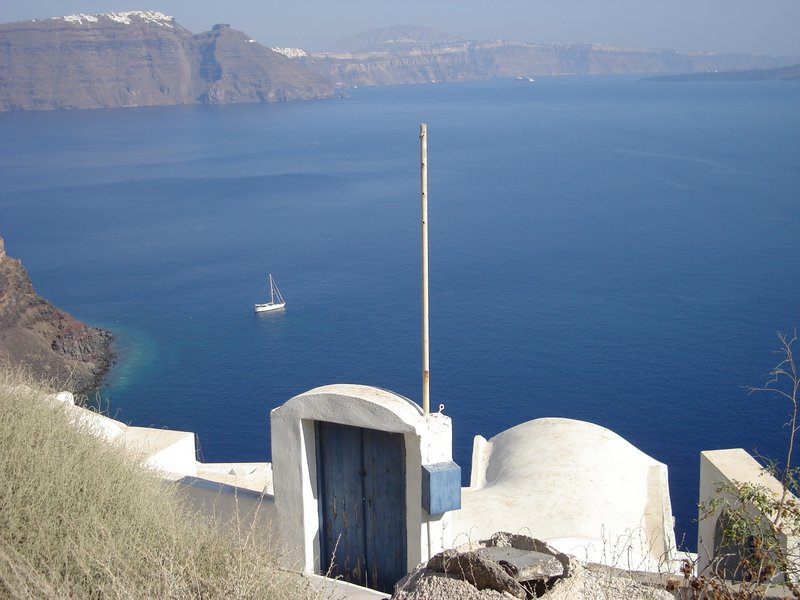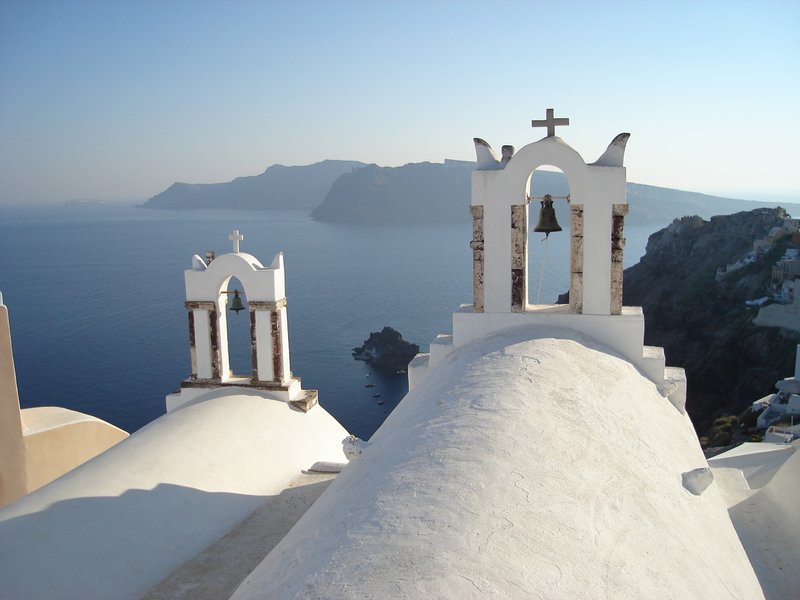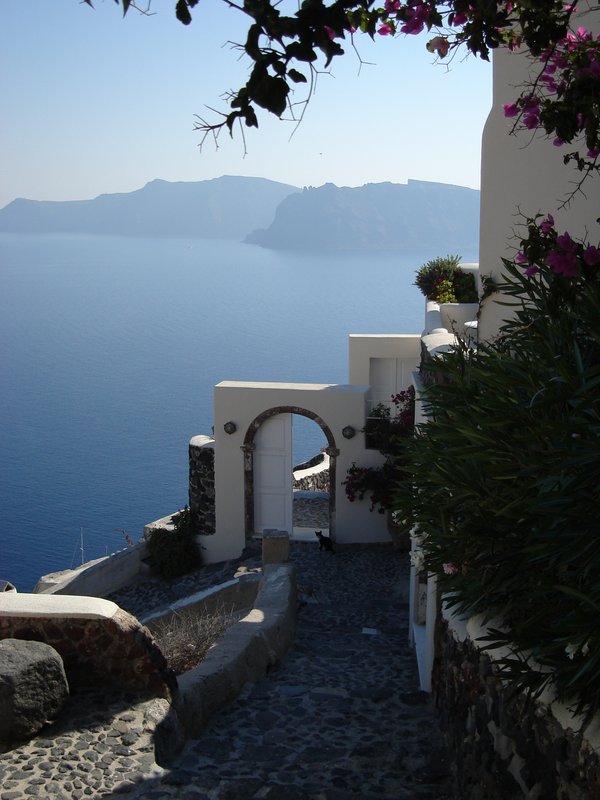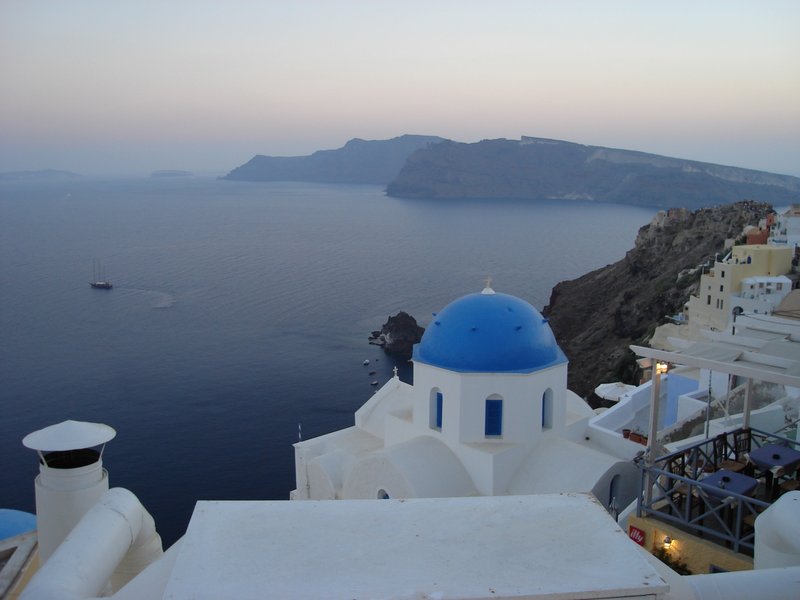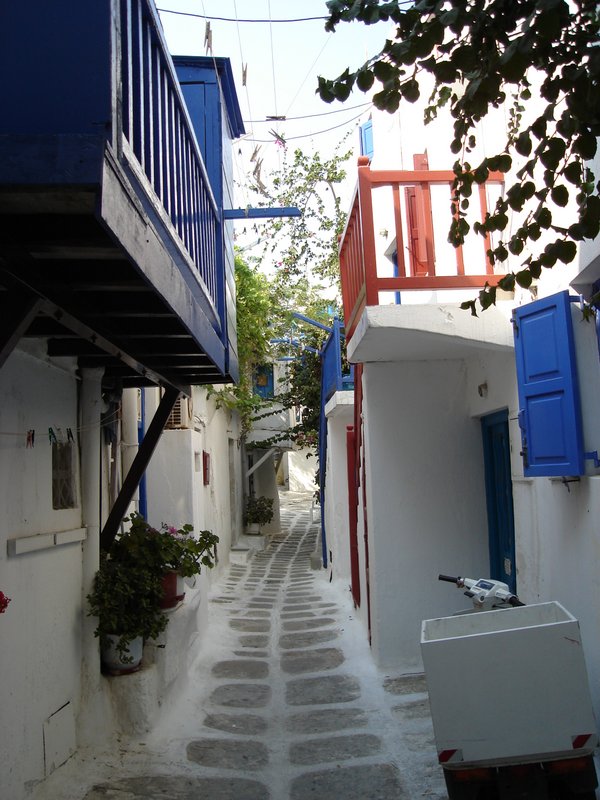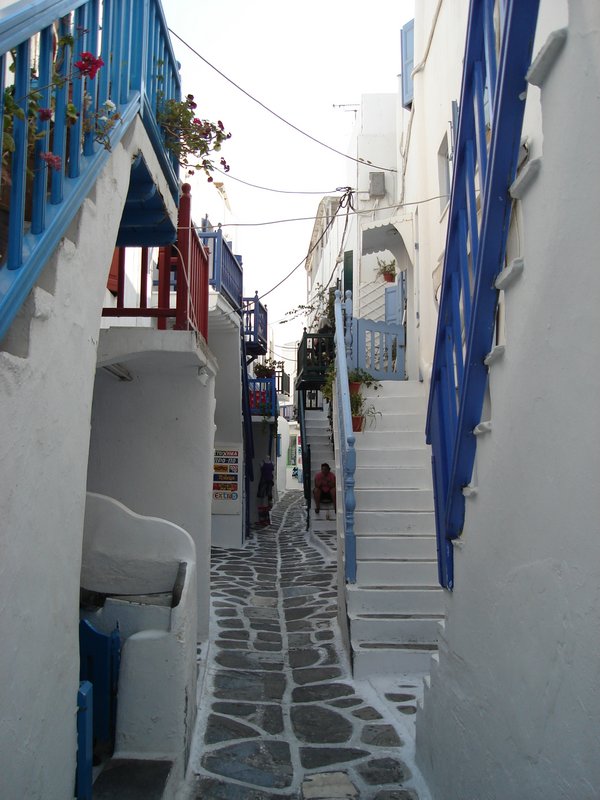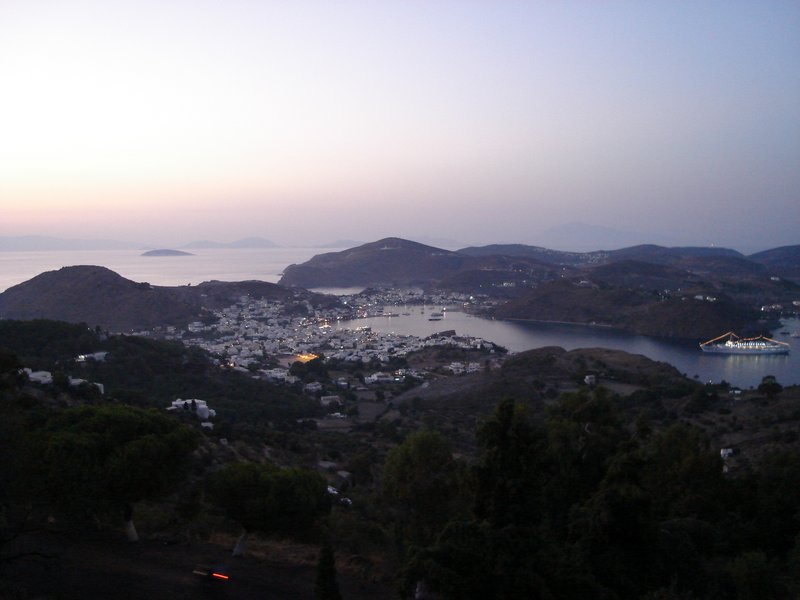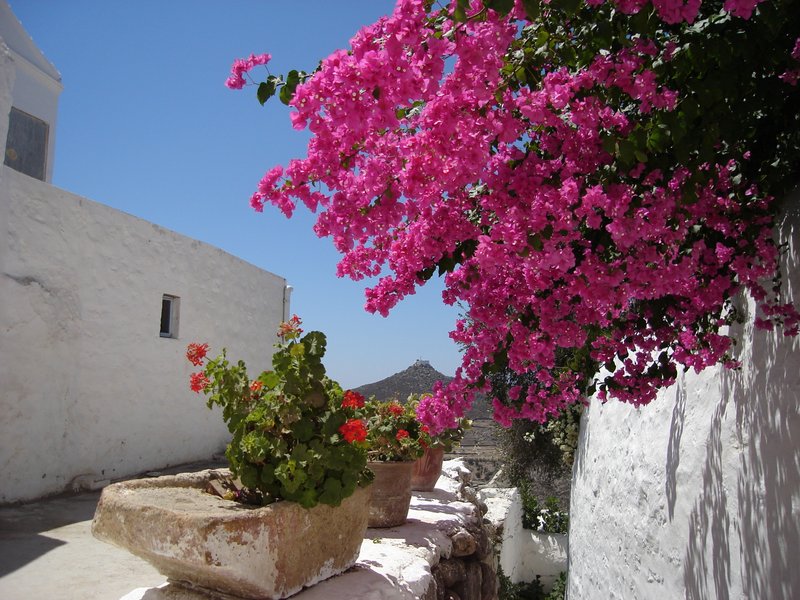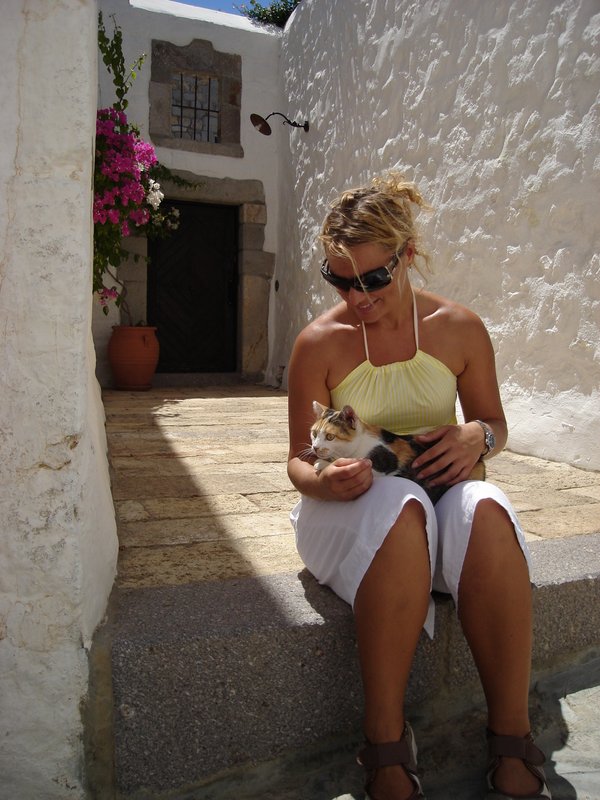The Cyclades group of islands is situated in the center of the Aegean and is so named because they surround the little island of Delos, just to the west of the holiday mecca of Míkonos. In ancient times, Delos was a center of trade and worship in the Aegean Sea, and its ruins are a popular tourist attraction.
Our first stop in the Cyclades was the island of Anáfi. While a few tourists manage to visit there, its major attraction for us was an overnight anchorage on its south shore with reasonable protection from the meltemi. While it was a bit rolly, it was an OK stopover between the islands of Astipálaia and Thíra (Santorini). The most notable part of the island aside from the typical village and castle, were the sheer rock cliffs on its eastern promontory, with a small whitewashed chapel perched some 450 meters/1400 feet on its highest point. It would have been a long hard walk to Sunday mass! We spent just one night there and then carried on west, sailing with wind on the beam in a fresh meltemi.
The following morning we sailed around the south end of Thíra and into the caldera of the sunken volcano bordered by the cluster of islands known as Santorini. The last eruption was about 4000 years ago, but looking at the rough rock faces and barren geology, it could have been four years ago. Today the area is believed to be the site of the lost city of Atlantis, which sunk into the sea or was blown to smithereens, destroying an entire civilization.
As we rounded the corner and headed northeast into the caldera, the white buildings of the villages of Ía and Fira sitting on the distant ridges resembled snow-capped mountains. As we drew closer, it is easy to see that Santorini is truly one of the most unique spots on the face of the planet.
Sailing in the caldera of Santorini
We made our way to the port of Firá, but it was way too deep to anchor and the moorings were all occupied. Our plan B was to anchor a couple of miles to the southwest between the volcanic islets of Nėa Kamméni and Néa Palaia Kamméni in the center of the caldera. The pilot book showed that there was some shallow water and reasonable protection from the meltemi. The anchorage proved to be very good and we were able to take the dinghy to the port that afternoon. We climbed the 700 steps from sea level to Firá, the main town in Santorini clinging to the rim of the volcano, and enjoyed sundowners and a dinner out.
The next morning we picked up the anchor and again headed for Firá and were fortunate to get space to tie a bow line to a very large and rusty ship’s mooring, and then tie long stern lines to some metal rings installed on the rocky shoreline. It was hard work, and Merima did a great job of keeping Moonshadow on station in the shifty breeze while I used the dinghy to take all the lines fore and aft and install chafe gear against the rusty metal attachment points. After all this effort we were in no hurry to move on too quickly, so we settled in to enjoy a few days in Santorini. Considering the number of yachts that visit this area, the facilities are severely lacking. Anchoring is impossible at Fira due to the extreme depths, there are too few moorings and the quay is not large enough for more than a few boats to med-moor. Most of the visiting cruise ships use a geostationary positioning system out in the open water of the caldera and use the local boatmen to ferry their passengers to and from shore.
Snug on the ship’s mooring in Firá
From above
Nice view to wake up to
Snug in the “harbor” at Firá, we enjoyed ourselves wandering the narrow streets of the village precariously perched on the edge of the volcanic cone. Our favorite time was late in the day, when the sunsets seemed to last for hours, and everyone would gather at one of the many view bars or restaurants to chill out, enjoy a drink and gaze out on the horizon while the hues gradually changed on the islands, buildings and cliffs. Afterwards, we would wander off to one of the many excellent restaurants to enjoy a nice Greek meal.
Sunset from Firá
Enjoying sundowners at a taberna in Firá
Getting to the village of Firá from the port of Firá and back can be a mission. One can take the funicular for €4 each way, but the last ride down is rather early by Greek standards at 10:30pm Another option is to hire a donkey to give you a jerky ride or down for about €10 each way. Most of the time, we opted to walk the 700 donkey dung covered steps. The cobbled trail zigzags up the sheer volcanic cliffs, and we found ourselves dodging the long lines of donkeys waiting for passengers at the top and bottom as well as avoiding being crushed or trampled by the donkey trains taking riders up or down. The donkey thing seemed quite novel at first, and we almost gave it a try, but seeing how hard the donkeys worked all day without food or water, we became disgusted with the owner/drivers abusive behavior and gave it a miss.
Donkeys are popular transport to and from Firá to the port below
After four days in Firá we moved to the northwestern tip of the island to a smaller village called Ía. Here we found a small shallow patch of rock and were able to anchor safely about 100 meters off the rugged cliff shoreline directly below the village. Ía is at a somewhat lower elevation and the trail has only 300 steps from the sea level to the village. There’s no funicular and only a few donkeys working, so the walk up was much more enjoyable, and the steps were much cleaner and better lit at night than those at Firá.
We spent one afternoon and evening in Ía, but found it to be very lovely as it was much quieter than Firá. There were fewer tourists and tourist shops, the village had some stunning views and the sunset was equally as spectacular.
Moonshadow anchored on a pinnacle at Ía
The beautiful serenity of Ía
Santorini is truly a special place, with incredible charm, beauty and spectacular vistas, but visiting by yacht requires a lot of effort and patience. We saw a T-shirt that summed it up perfectly: “Nothing is easy in Santorini.”
We took advantage of a lull in the meltemi and moved north to the island Íos. As we were heading ashore in the dinghy to check out the village, the wind picked up and we were bashing into the chop. This stirred up a heap of sediment in the gas tank that we had unknowingly acquired when we bought fuel in Suakin (Sudan). The engine died and wouldn’t re-start. Fortunately Moonshadow was downwind so we were able to row back home. Had the wind been blowing the other way, this story might have ended about six lines up.
We left the next morning before the meltemi picked up and made it to the island of Páros. We anchored in the large and calm bay off the main town of Paroikiá.
I completely cleaned the carburetor and fuel system of the outboard, gave it a dose of clean fuel and once again she ran like a champ. We headed in to town and had a walk around and an excellent dinner in the courtyard of an old olive press in town.
We spent one more day in Paroikiá wandering along the old market street, checking out the shops, cafes and beautiful architecture along the narrow stone walkways and enjoyed a wood-fired pizza at a waterfront taverna around sunset. Had we turned eastward and made our way towards Turkish waters, our visit to the Cyclades would have been perfect.
The next day we headed north again to the tourist mecca of Míkonos. As we approached the channel between Míkonos and Delos, the wind piped up to the mid to high 20’s and it began to get choppy. We went to the “new harbor” north of Míkonos Town where there is a “marina.” The marina has been work in progress for at least five years and still has no power or water. It’s obvious that the jetty was built to accommodate the big cruise ships and the facility for visiting yachts sits unfinished and appears to be of no concern to anyone. Boats are tied up haphazardly, some side-tied, some med-moored and the use of space is ludicrous. There was no space for us so we ended up anchoring in a small, partially protected bay just to the north of the harbor. By then, bullets were coming through the hills into the low 30 knot range.
There were no taxis available to get us to town, and walking on the narrow road with large buses whizzing past didn’t look too appealing let alone safe. We managed to con one of the cruise ship shuttle bus drivers into taking us into town and gave him a tip.
We were dropped at the ferry terminal in the old harbor, which was a mass of humanity. There were long queues for everything. After checking in with the Port Police we took a stroll around town, getting away from the wind-swept waterfront and into some of the more interesting narrow streets. While Míkonos is very quaint and picturesque, it seems to be one of the poseur capitals of the Mediterranean. We noticed that nearly every expensive designer label has a boutique in Míkonos Town and if people aren’t on the beach soaking up the sun, they are perusing the shops of this European version of Rodeo Drive. Not exactly why we came to Greece. We couldn’t really see what all the fuss was about with Míkonos, so we headed back to Moonshadow where we spent an uncomfortable evening at anchor and planned to depart the next day.
Exploring the quiet back streets of Míkonos
Not every day out here is fun and games. After our frustrating experience with Míkonos Marina, we decided to head around to the south side of Míkonos, and anchor in one of the little bays off a beach resort for the evening. In addition to positioning ourselves eleven miles closer to our next port of call, the island of Pátmos, we reckoned that a protected cove in the lee of the island would be much calmer and more comfortable than the semi-protected, wind-blown spot we were in near the “marina.” Wrong-a-mundo!
Perhaps after sailing across the Indian Ocean and up the Red Sea, we let our guard down a bit, or perhaps we underestimated the mighty meltemi, or both. In any event, we didn’t have a very good day at the office.
We picked up the anchor at about 0930 in gusty winds. Bullets were coming through the hills at up to 30-35 knots. The anchor, which had been very well set, came up with no dramas and we headed back through the channel between Míkonos and Delos Islands. To keep things simple, we just rolled out about half the working jib and were sailing along nicely at 7-8 knots, nearly dead down wind. Everything was hunky dory.
We rounded the bottom of Míkonos Island and turned to the east and trimmed on the sail. We were a bit overpowered but sailing along nicely at 9 knots with the wind just forward of the beam. I considered rolling up a bit more sail, but we weren’t going much further, and I expected to find a nice calm spot in the lee of the islands where we might easily roll up the sail just before we anchored. That was the second mistake. The first was leaving a safe anchorage in crap weather. The wind picked up and we were taking gusts up to 40 knots.
We came abeam the place we wanted to anchor so I bore away and we rolled up the headsail. Because it was so windy and the sail was flogging, we didn’t make a very good job of it. The jib was bunched up and twisted in places and the sheets were tangled – not the way we would have liked it. We managed to get it all furled up and headed for the anchorage. The anchorage didn’t afford much protection from the meltemi, but at least it wasn’t rolly. It was about the best option we had at the time. We could imagine all the people on the beach imagining how nice it would be to be sailing the Greek Isles on a yacht, while we would have been happy to be sitting on terra firma with sand blowing on our beach towels instead of gale force winds whistling through the rigging.
Once we were anchored we managed to clear the fouled sheets but left the jib as it was, figuring we would unroll it when we next sailed and it would sort itself out. That was mistake number three. An hour or so later when we were relaxing down below, the top of the sail came out and starting flogging wildly in the gale force winds. We tried to unfurl it but it became wrapped around the headstay, flogging away, jerking the rig around. It felt as if Moonshadow had been placed in a giant paint mixing machine. We managed to get it partly furled again but part of the sail was still flogging and would have eventually self destructed, while endlessly shaking the rig. Merima suggested we pick up the anchor, steer dead down wind and try to get it sorted out with the wind behind us. We sprung into action, got the anchor up and put the plan into action.
As we steered downwind with just a little bit of sail flogging, we were making 8 knots. There are times when you don’t want your boat to be fast and this was definitely one of them as we didn’t want to get too far downwind of the anchorage. By rolling up the sail and letting it out, heading up and luffing, then bearing away again, we managed to make some slow progress against the bunched up bit, but not before a gust came along and ripped off the webbing straps holding the clew ring to the sail. We finally got it fully unfurled and managed to roll the sail up tightly and completely. Because we no longer had sheets attached to the sail, Merima and I went forward with two spinnaker halyards and did the maypole dance around the headstay and managed to secure the jib once and for all. Total damage, one clew fitting ripped out, and some of the rather old sacrificial UV cloth in tatters. It could have been a whole lot worse!
Relieved that major catastrophe had been averted, we turned the boat around and headed into wind and seas, back to the anchorage where we could lick our wounds and relax. Wrong again!
As we approached the anchorage, a strong gust of wind, 50+ knots, ripped out one of the stainless bars supporting the bimini top. Yes, that would have been the bimini top that had been on since Singapore last August (7200 nm ago) and should have been taken down a couple days ago when the winds piped up. Mistake number four. There’s an old saying that applies to sails and awnings: “If you don’t take them down in time, God will.” That is precisely what happened. Anyway, the bimini flapping in the wind was swinging the ten foot long stainless pole more furiously than Barry Bonds swings a baseball bat when he’s trying to set a new home run record. While neither of us were wearing batting helmets, we still managed to control and restrain the pole while cutting away the tethering lines of the bimini top cloth, steering the boat (we couldn’t reach the autopilot control), hanging on for our lives in the wind and swell, dodging fire-hose force sea spray and cursing the @*%$#&! meltemi. All we could do at this stage was look at each other and laugh, wondering what could possibly happen next.
We made it safely back to the anchorage, and on the second attempt managed to get Moonshadow securely anchored, cleaned up the mess, licked a few more wounds, had a few rums to ease the pain, and looked in the Greek Maritime Yellow Pages to find the nearest sail loft. We also made a note to re-read the Dashew’s article on awnings the next time we’re on line. All we could do then was wait for the meltemi to ease so we could head east to Pátmos.
The following afternoon we were down below, catching up on some writing, and biding our time. All of a sudden, I heard a loud thud on the hull. An idiot riding a Jet Ski (is this redundant word usage?) ran into the port bow of Moonshadow. Fortunately there wasn’t any serious injury or damage, but I did go ashore and have a conversation with the manager of the Jet Ski rental outfit about my concerns with the safety of high speed passes in close enough proximity to send water up on to our decks and into open hatches. His apparent concern was underwhelming to me, but he did assure me that he had a remote control kill switch and could stop any Jet Ski getting too close to anything. Sure! Ten minutes later, they were buzzing us within a few meters again. With the poor safety record of personal watercraft, and the way we usually see them operated, perhaps they are just a high tech method of cleansing the gene pool.
The following morning, in a bit of a lull, we sailed for Pátmos, back in the more docile Dodacanese Island group along the southwest coast of Turkey. We started out reaching with just a staysail, making 6-7 knots, but by the time we got in the lee of Icaría, about half way to Pátmos, the wind had dropped to less than ten knots and we were motor-sailing. It was great to be out of the central Aegean Sea and the full force of the summer meltemi.
In the protected bay of Pátmos we were able to tie up to the bulkhead. While there was no power and water on the bulkhead, Pátmos was somewhat more user friendly than many of the Greek harbors we had visited. There were daily visits by mini tankers selling water and diesel, and across the street were a mini market, fruit shop, bakery, hardware store, and an Internet café that also had toilets and showers for rent to the yachties.
Pátmos was a pleasant enough town with the obligatory castle perched on the top of the hill overlooking the harbor. Our arrival timing to Pátmos was good as the rising full moon would clear the horizon just over the castle, making evenings there quite beautiful. We enjoyed a few days in a calm harbor after our ordeal out at Míkonos.
View of Pátmos from the Hóra
After getting Moonshadow tidied up a bit, we took an 8 kilometer round trip walk up to Hóra, the village surrounding the castle. On the way up we stopped in to the Cave of the Apocalypse, where John wrote the Book of Revelations during his exile to Pátmos in the first century A.D.
The colours of Pátmos
Merima mixing with a local on Pátmos
We were itching to get to Turkey and into a proper marina with all the usual amenities, so we headed south to the island of Kós, the nearest port of entry where we could complete checkout formalities. Kós appeared to be afflicted with a pretty bad case of tourism so we only spent one night anchored off the town. The following morning, we checked out of Greece almost as easily as we had checked in, and headed northeast ten miles to the Turkish port of Bodrum. Merima managed to sweet talk the dock master into giving us a berth in the Milta Bodrum Marina even though we had no prior booking. A pilot came out to guide us in, handed us a mooring line for the bow and an attendant was waiting on the dock to tie our stern lines. Ahh, the way it should be!
Reflecting back, our time in Greece was mostly enjoyable. While the Greeks have clearly missed the boat as it relates to facilities for yachties, perhaps it keeps the crowds away. We thoroughly enjoyed the warm and friendly people, beautiful and historic towns and villages, quaint architecture and of course the excellent food and wine. We’ll miss those things and look forward to spending more time in the Greek Isles next season.

